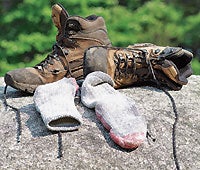How to Prevent Blisters

'Photo by Erin Paul Donovan'
Subtitles: 4 remedies to reduce blisters, chafing, and odor
Stuffed inside wool socks and cramped boots, your feet have every right to perspire. And they will–through more than 125,000 sweat glands on the sole of each foot. That’s not a problem if your body has a typical cooling system; just hike all day, air-dry boots and socks at night, and continue the next morning in comfort. But hikers who sweat more than usual or suffer from overactive sweat glands–a condition called plantar hyperhidrosis–can find themselves in trouble on the trail. Excessively sweaty feet can increase the odds of getting blisters and infections, produce terrible foot odor, ruin socks and footwear, and create conditions for cold injuries like frostbite and trench foot. Here’s how to handle the excessive perspiration.
Absorb
Wear polyester or wool socks that wick away moisture. Exchange wet socks for a dry pair as often as possible. Tie the soaked socks to the outside of your pack, where they’ll dry out as you hike–even in cold weather. Dry boots overnight by propping the tongues open with twigs.
Apply
Use extra-strength antiperspirant creams, roll-ons, or powders to reduce sweating and odor. Bromi-Lotion Antiperspirant cream ($12.50; americarx.com) contains aluminum hydroxychloride, an ingredient to block skin pores that’s stronger than what’s found in regular deodorants. Equally effective is Certain Dri Antiperspirant ($5; americarx.com), a fragrant-free roll-on with aluminum chloride that won’t wash off in water, and can be applied to feet several times a week at bedtime. Fight fungus and chafing skin with Gold Bond Medicated Foot Powder or Zeasorb, a talc-based absorbent powder; both are available at drug stores.
Support
Buy aftermarket insoles specifically designed to absorb sweat, like DryZ foam cushions ($16-$21; shoeline.com), which wick foot moisture and store it in the insole’s gel-like core (to evaporate later when you remove your boots).
Treat
Consult a doctor for serious cases of plantar hyperhidrosis that don’t respond to over-the-counter remedies. Long-lasting solutions include skin surgery, botox injections, and iontophoresis; the latter is a noninvasive electro-chemical treatment that clogs sweat glands, and can be administered periodically by a dermatologist.